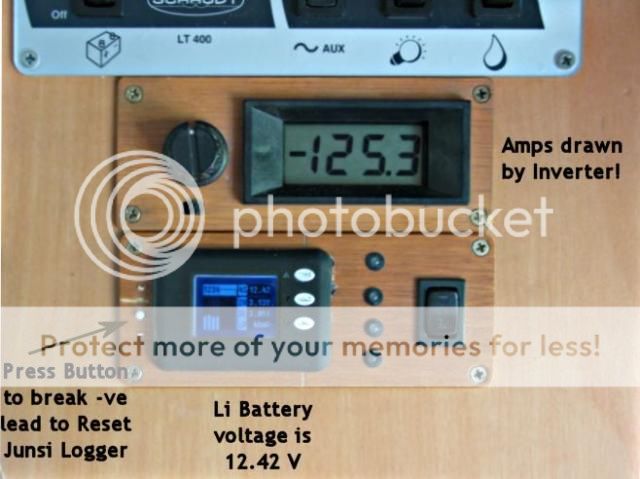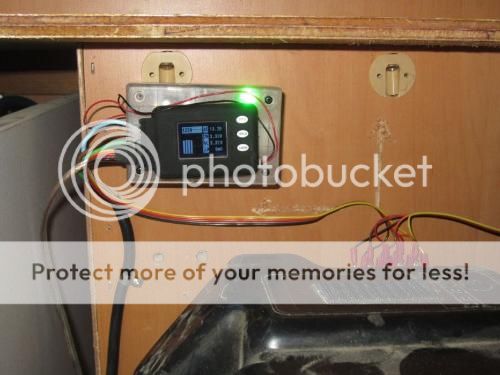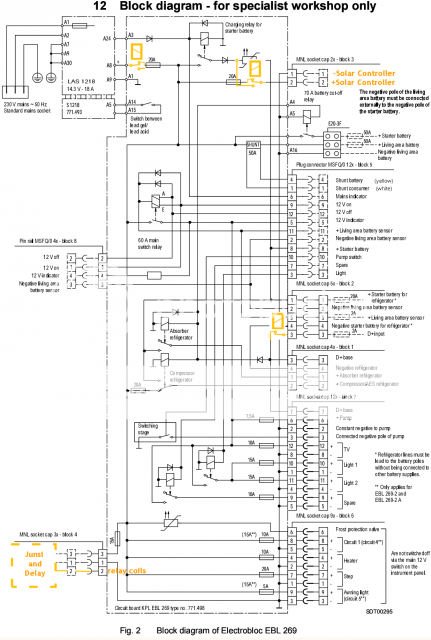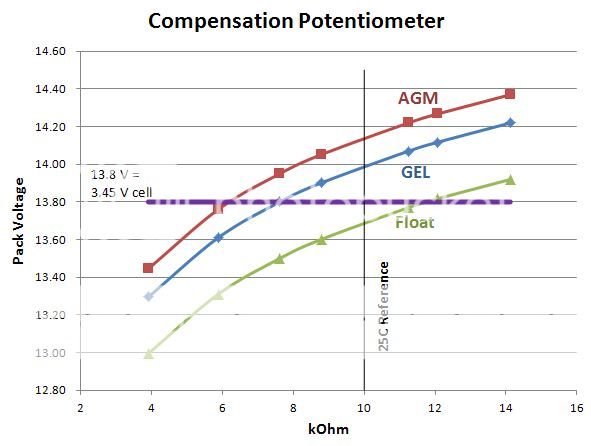Lithium Batteries, who has them?
-
SteveW

- Posts: 2343
- Joined: Sun Dec 09, 2012 9:03 pm
- Location: Glenelg, South Australia
Re: Lithium Batteries, who has them?
I'm anything but an expert on this stuff, however, what you are saying is more or less what I understood they are aiming for. Bodes well for the future.
Steve Williams
http://stevew1945blog.com/
Every absurdity has a champion to defend it.
Oliver Goldsmith. 1728 -1774
http://stevew1945blog.com/
Every absurdity has a champion to defend it.
Oliver Goldsmith. 1728 -1774
-
generdawg

- Posts: 1253
- Joined: Tue Dec 04, 2012 12:06 pm
- Location: St Huberts Island
Re: Lithium Batteries, who has them?
"Stanford scientists have engineered a smart battery that can detect fires before they happen", says this article.
Experience is a wonderful thing. It helps you recognise a mistake when repeated.
-
T1 Terry

- Posts: 16493
- Joined: Fri Nov 23, 2012 3:44 pm
- Location: Mannum South Australia by the beautiful Murray River
- Has thanked: 66 times
- Been thanked: 48 times
Re: Lithium Batteries, who has them?
They might be able to finally make lithium polymer cells safe, this would be big step forward as lithium polymer are much lighter than lithium ferrous for the same amount of energy stored and can be discharged and recharged much faster than lithium ferrous, the down side is they produce oxygen at the point of failure so the fuel their own fire causing the high temp fires that are normally and incorrectly linked to all types of lithium batteries. Lithium ferrous or LiFeP04 cells do not produce oxygen at any stage during charging or discharging so they can not explode in flames, just pop their case if the temp and pressure reaches extremes.generdawg wrote:"Stanford scientists have engineered a smart battery that can detect fires before they happen", says this article.
In lithium ferrous cells the dendrite build up can kill a cell via dead short between the plates, but smart cell conditioning before use virtually eliminates the possibility of this happening by first building an even coating across the graphite material there for eliminating any specific point for the dendrite to build. This way if dendrite does build up it will be across the whole plate area and there is not enough free lithium to build a big enough layer to penetrate the separator before the supply of lithium is exhausted. With no free lithium available in the electrolyte no further lithium ion transfer can occur and the cell simply stops working, the only noticeable sign is a loss of capacity, no smoke, no fire, no sudden dead battery, it just doesn't work as well as it did. This would show up on the cell monitoring long before any thing like this could happen so it would only be possible with a non monitored battery with a poor or failed charging system.
T1 Terry
A person may fail many times, they only become a failure when they blame someone else John Burrows
Those who struggle to become a leader, rarely know a clear direction forward for anyone but themselves
Those who struggle to become a leader, rarely know a clear direction forward for anyone but themselves
-
Wilbor

- Posts: 795
- Joined: Wed Dec 05, 2012 1:58 pm
- Location: Ingham NQ
Re: Lithium Batteries, who has them?
Common T1, we're patiently waiting for more 
Rob
Swagman
WILBOR-TOO
Why I Like Being On Road - Too
Swagman
WILBOR-TOO
Why I Like Being On Road - Too
-
T1 Terry

- Posts: 16493
- Joined: Fri Nov 23, 2012 3:44 pm
- Location: Mannum South Australia by the beautiful Murray River
- Has thanked: 66 times
- Been thanked: 48 times
Re: Lithium Batteries, who has them?
Sorry, been suffering the headaches bad, had to attend specialist appointments in central Sydney yesterday and was supposed to attend another tomorrow, but I appear to have left my x rays some where in Syd, so now it's a frantic ring around all the possibilities we can think of to see if that's where I left them. It appears I'm not alone, to coffee shops have x rays from yesterday, just not ours, just hoping it's at the specialist (they are not answering the phone) and not at a station or on the train.
Off to do a bit more on Mazda's eng today, well I'm attending to watch Eddie do it, after 1 hrs sleep last night and another 2 hrs this morning I'm all out of clever....... anything at the moment
Off to do a bit more on Mazda's eng today, well I'm attending to watch Eddie do it, after 1 hrs sleep last night and another 2 hrs this morning I'm all out of clever....... anything at the moment
A person may fail many times, they only become a failure when they blame someone else John Burrows
Those who struggle to become a leader, rarely know a clear direction forward for anyone but themselves
Those who struggle to become a leader, rarely know a clear direction forward for anyone but themselves
-
Mrcoolabah1au
- Posts: 2699
- Joined: Wed Jan 23, 2013 3:36 pm
- Location: Tocumwal on the Murray river
Re: Lithium Batteries, who has them?
Thank you
Hope the bus is going shortly
And the Head gets better
Good luck with the xxxrays
Hope the bus is going shortly
And the Head gets better
Good luck with the xxxrays
Coolabah1au
Wayne nini
Wayne nini
-
Wilbor

- Posts: 795
- Joined: Wed Dec 05, 2012 1:58 pm
- Location: Ingham NQ
Re: Lithium Batteries, who has them?
Get yourself well first Terry. I'm just hungry for more infoT1 Terry wrote:Sorry, been suffering the headaches bad, had to attend specialist appointments in central Sydney yesterday and was supposed to attend another tomorrow, but I appear to have left my x rays some where in Syd, so now it's a frantic ring around all the possibilities we can think of to see if that's where I left them. It appears I'm not alone, to coffee shops have x rays from yesterday, just not ours, just hoping it's at the specialist (they are not answering the phone) and not at a station or on the train.
Off to do a bit more on Mazda's eng today, well I'm attending to watch Eddie do it, after 1 hrs sleep last night and another 2 hrs this morning I'm all out of clever....... anything at the moment
Rob
Swagman
WILBOR-TOO
Why I Like Being On Road - Too
Swagman
WILBOR-TOO
Why I Like Being On Road - Too
-
PeterM
- Posts: 47
- Joined: Wed Dec 12, 2012 8:27 am
Re: Lithium Batteries, who has them?
I sold my 2006 A'van Applause 500 motorcamper (http://manins.net.au/motorhome/sitemap.html) a year after converting the power system to LiFeYPO4. The new owner is happy so far  .
.
I started with six years' experience with the existing power management system which consisted of :
* a single Fullriver HGL120-12B AGM battery, a 120 Ah 12V battery that was not holding much charge after five years of occasional use.
* an Elektroblock EBL 269-2 electrical monitor, charger and distribution system.
* The Elektroblock includes an 18A LAS 1218 230 V charger module that on LA setting gives out 14.3 V max for up to 1 hour in absorption phase and 13.8 V in float phase.
* The Elektroblock includes input from the vehicle alternator controlled by the alternator's D+ signal such that only when the engine is running will the alternator feed power to the Elektroblock. I observed a maximum of 25 A (briefly) from the alternator, limited I suspect by the 18 m (sic) of cable between the alternator and the Elektroblock in the back of the van.

* 245 W of solar panels feeding into a ProStar PS-15M Controller, a 15 A PWM solar regulator that on AGM setting gives out 14.15 V max up to 1 hour in absorption phase and 13.7 V in float phase.
The Elektroblock is a serious bit of kit that Avan continues to fit to most of its motorhomes and motorcampers, so my starting point is widespread. Because of the integrated nature of the setup, I was very reluctant to change these components.
When camped up, typically we used approximately 63 Ah/24 hours, of which 33 Ah was in non-daylight.
My experience was that for southern latitude use in winter we were very constrained by our single battery. By changing to a 100 Ah LiFePO4 battery we would have approx. 80 Ah available (20% DoD), an increase from the 46--60 Ah available from the AGM (30%--50% DoD). That is an increase of 33--90%. That, coupled with the better charging performance of a Li battery on solar, and there being no need to keep the battery as fully charged as possible, has greatly improved our ability to stay off hook.
I purchased 4 x 100 Ah LiFeYpo4 cells from http://www.thebackshed.com/basiclynatur ... 3=NA&id=49 Basicly Natural with end straps and links for $707.
The new Li Battery fits in the original Box (with extra padding) and is wired to the battery board using heavy welding cables.

Two https://www.hobbyking.com/hobbyking/sto ... _Lipo.html Junsi 8M Cell Monitors are used.
** One ( ) monitors and displays cell voltages and has alarms set for over and under voltage, with output to a piezo siren. The alarm voltages are set as on the displayed voltages sign that is next to the Junsi in the camper living module.
) monitors and displays cell voltages and has alarms set for over and under voltage, with output to a piezo siren. The alarm voltages are set as on the displayed voltages sign that is next to the Junsi in the camper living module.
**The other Junsi ( ) controls both High Voltage Cut and Low Voltage Cut in the event that the solar, mains charger, or alternator charger cause excessive charging, or if loads unduly drain the battery. The control voltages used are as for the Monitoring Junsi except that they are 0.05 V tighter. An ATTiny85 microcontroller is used to decide whether the Junsi has sensed HVC or LVC and then initiates the appropriate cut and 4 minute delay before restoring charging to the battery. The circuit diagram is here:
) controls both High Voltage Cut and Low Voltage Cut in the event that the solar, mains charger, or alternator charger cause excessive charging, or if loads unduly drain the battery. The control voltages used are as for the Monitoring Junsi except that they are 0.05 V tighter. An ATTiny85 microcontroller is used to decide whether the Junsi has sensed HVC or LVC and then initiates the appropriate cut and 4 minute delay before restoring charging to the battery. The circuit diagram is here:

and the code for the microcontroller can be read here: http://www.manins.net.au/motorhome/imag ... _Delay.txt .
The LVC is carried out by a manually resettable 100A latching relay ( ). A 1500 W inverter is not handled by this relay, but it has its own monitoring buzzer, light and LVC.
). A 1500 W inverter is not handled by this relay, but it has its own monitoring buzzer, light and LVC.
The HVC is carried out by three 30A horn SPDT relays ( ) that cut each of solar charge, mains charge and alternator charge. I installed the relays inside the OEM Elektroblock that manages all the loads and charges. I modified the Elektroblock circuitboard to achieve the required functions, and T1 Terry played a vital role in deciding how this would be done.
) that cut each of solar charge, mains charge and alternator charge. I installed the relays inside the OEM Elektroblock that manages all the loads and charges. I modified the Elektroblock circuitboard to achieve the required functions, and T1 Terry played a vital role in deciding how this would be done.

**to permit control of the solar charge inside the Elektroblock, I cut charge to the Li battery with a horn relay but maintain the 2A limited charge to the starter battery. The latter keeps the regulator happy that it is still connected to a battery of known voltage. This and using the solar regulator's temperature compensation circuit to shift charge voltages down to a safer level works well.

**the alternator charge is cut by a horn relay activating an inbuilt 70A relay in the Elektroblock that does this. Since the starter battery continues in circuit with the alternator all is well.
**the mains charger current is simply interrupted by a horn relay.
The system performs well. The alternator charges the LiFe battery at 10A for hours, right up until the battery is full. I have seen over 25A charge rate on occasion when the battery was low. Solar performance is also much improved, and again the maximum possible charge belts in until the battery is full.
I have made several cell balancing attempts, but really they probably have been more interference than necessary.
The Junsi/Microcontroller system does activate frequently, since the primary charging source characteristics are a little on the high side, but this does not seem to be a problem. If the control system fails the most likely situation is that the primary charging sources will continue to function and their less conservative limits will protect the battery albeit less well.
I commend the use of two Junsi celllogs: 1 for monitoring with the display in clear view (my mod to the cable connector allows for a nice mounting of the Junsi) and 1 for control.
I commend the use of the Microcontroller for handling the decision whether the Junsi alarm is High or Low Voltage, and for implementing the delay function. The software is easy to understand and to change or debug, and the circuitboard is really easy to use for troubleshooting since removing the microcontroller chip gives easy access on the chip socket to all important voltages.
I also should mention that at the beginning I should have taken the possibility of being able to use the enhanced power available from the LiFe battery more seriously. As it was, I only late in the build decided on adding the 1500 W inverter to the system. This works well and has been very popular with the chef, since she could use the microwave oven and hair dryer when remote camping (I think we call that "glamping" here).
Is the added complexity of monitoring and acting upon HVC and LVC something that makes LiFe batteries too difficult to implement? I don't think so. Serious implementation of ANY battery really should have charge and discharge monitoring and management included. The extra is that you MUST be doing this at the cell level, something not possible with AGM batteries. With lead-acid, you can get away with a lot of abuse but it does shorten battery life.
Thank you, T1 Terry, and Plendo, and others who helped me come to grips with this LiFe technology, Junsi's and the ATTiny microcontroller. Its all very well to understand what to do in principle ("I read it in a booook"); its quite another to actually do it. Experience is vital, but building only one system is far too small an experience to say I am skilled enough to advise others.
I started with six years' experience with the existing power management system which consisted of :
* a single Fullriver HGL120-12B AGM battery, a 120 Ah 12V battery that was not holding much charge after five years of occasional use.
* an Elektroblock EBL 269-2 electrical monitor, charger and distribution system.
* The Elektroblock includes an 18A LAS 1218 230 V charger module that on LA setting gives out 14.3 V max for up to 1 hour in absorption phase and 13.8 V in float phase.
* The Elektroblock includes input from the vehicle alternator controlled by the alternator's D+ signal such that only when the engine is running will the alternator feed power to the Elektroblock. I observed a maximum of 25 A (briefly) from the alternator, limited I suspect by the 18 m (sic) of cable between the alternator and the Elektroblock in the back of the van.

* 245 W of solar panels feeding into a ProStar PS-15M Controller, a 15 A PWM solar regulator that on AGM setting gives out 14.15 V max up to 1 hour in absorption phase and 13.7 V in float phase.
The Elektroblock is a serious bit of kit that Avan continues to fit to most of its motorhomes and motorcampers, so my starting point is widespread. Because of the integrated nature of the setup, I was very reluctant to change these components.
When camped up, typically we used approximately 63 Ah/24 hours, of which 33 Ah was in non-daylight.
My experience was that for southern latitude use in winter we were very constrained by our single battery. By changing to a 100 Ah LiFePO4 battery we would have approx. 80 Ah available (20% DoD), an increase from the 46--60 Ah available from the AGM (30%--50% DoD). That is an increase of 33--90%. That, coupled with the better charging performance of a Li battery on solar, and there being no need to keep the battery as fully charged as possible, has greatly improved our ability to stay off hook.
I purchased 4 x 100 Ah LiFeYpo4 cells from http://www.thebackshed.com/basiclynatur ... 3=NA&id=49 Basicly Natural with end straps and links for $707.
The new Li Battery fits in the original Box (with extra padding) and is wired to the battery board using heavy welding cables.

Two https://www.hobbyking.com/hobbyking/sto ... _Lipo.html Junsi 8M Cell Monitors are used.
** One (
 ) monitors and displays cell voltages and has alarms set for over and under voltage, with output to a piezo siren. The alarm voltages are set as on the displayed voltages sign that is next to the Junsi in the camper living module.
) monitors and displays cell voltages and has alarms set for over and under voltage, with output to a piezo siren. The alarm voltages are set as on the displayed voltages sign that is next to the Junsi in the camper living module.**The other Junsi (
 ) controls both High Voltage Cut and Low Voltage Cut in the event that the solar, mains charger, or alternator charger cause excessive charging, or if loads unduly drain the battery. The control voltages used are as for the Monitoring Junsi except that they are 0.05 V tighter. An ATTiny85 microcontroller is used to decide whether the Junsi has sensed HVC or LVC and then initiates the appropriate cut and 4 minute delay before restoring charging to the battery. The circuit diagram is here:
) controls both High Voltage Cut and Low Voltage Cut in the event that the solar, mains charger, or alternator charger cause excessive charging, or if loads unduly drain the battery. The control voltages used are as for the Monitoring Junsi except that they are 0.05 V tighter. An ATTiny85 microcontroller is used to decide whether the Junsi has sensed HVC or LVC and then initiates the appropriate cut and 4 minute delay before restoring charging to the battery. The circuit diagram is here:
and the code for the microcontroller can be read here: http://www.manins.net.au/motorhome/imag ... _Delay.txt .
The LVC is carried out by a manually resettable 100A latching relay (
 ). A 1500 W inverter is not handled by this relay, but it has its own monitoring buzzer, light and LVC.
). A 1500 W inverter is not handled by this relay, but it has its own monitoring buzzer, light and LVC.The HVC is carried out by three 30A horn SPDT relays (
 ) that cut each of solar charge, mains charge and alternator charge. I installed the relays inside the OEM Elektroblock that manages all the loads and charges. I modified the Elektroblock circuitboard to achieve the required functions, and T1 Terry played a vital role in deciding how this would be done.
) that cut each of solar charge, mains charge and alternator charge. I installed the relays inside the OEM Elektroblock that manages all the loads and charges. I modified the Elektroblock circuitboard to achieve the required functions, and T1 Terry played a vital role in deciding how this would be done.
**to permit control of the solar charge inside the Elektroblock, I cut charge to the Li battery with a horn relay but maintain the 2A limited charge to the starter battery. The latter keeps the regulator happy that it is still connected to a battery of known voltage. This and using the solar regulator's temperature compensation circuit to shift charge voltages down to a safer level works well.

**the alternator charge is cut by a horn relay activating an inbuilt 70A relay in the Elektroblock that does this. Since the starter battery continues in circuit with the alternator all is well.
**the mains charger current is simply interrupted by a horn relay.
The system performs well. The alternator charges the LiFe battery at 10A for hours, right up until the battery is full. I have seen over 25A charge rate on occasion when the battery was low. Solar performance is also much improved, and again the maximum possible charge belts in until the battery is full.
I have made several cell balancing attempts, but really they probably have been more interference than necessary.
The Junsi/Microcontroller system does activate frequently, since the primary charging source characteristics are a little on the high side, but this does not seem to be a problem. If the control system fails the most likely situation is that the primary charging sources will continue to function and their less conservative limits will protect the battery albeit less well.
I commend the use of two Junsi celllogs: 1 for monitoring with the display in clear view (my mod to the cable connector allows for a nice mounting of the Junsi) and 1 for control.
I commend the use of the Microcontroller for handling the decision whether the Junsi alarm is High or Low Voltage, and for implementing the delay function. The software is easy to understand and to change or debug, and the circuitboard is really easy to use for troubleshooting since removing the microcontroller chip gives easy access on the chip socket to all important voltages.
I also should mention that at the beginning I should have taken the possibility of being able to use the enhanced power available from the LiFe battery more seriously. As it was, I only late in the build decided on adding the 1500 W inverter to the system. This works well and has been very popular with the chef, since she could use the microwave oven and hair dryer when remote camping (I think we call that "glamping" here).
Is the added complexity of monitoring and acting upon HVC and LVC something that makes LiFe batteries too difficult to implement? I don't think so. Serious implementation of ANY battery really should have charge and discharge monitoring and management included. The extra is that you MUST be doing this at the cell level, something not possible with AGM batteries. With lead-acid, you can get away with a lot of abuse but it does shorten battery life.
Thank you, T1 Terry, and Plendo, and others who helped me come to grips with this LiFe technology, Junsi's and the ATTiny microcontroller. Its all very well to understand what to do in principle ("I read it in a booook"); its quite another to actually do it. Experience is vital, but building only one system is far too small an experience to say I am skilled enough to advise others.
-
Dot

- Posts: 24932
- Joined: Fri Nov 23, 2012 6:12 pm
- Location: Strathalbyn SA
- Been thanked: 54 times
Re: Lithium Batteries, who has them?
generdawg wrote:"Stanford scientists have engineered a smart battery that can detect fires before they happen", says this article.
So can fire bugs
Queen of the Banal & OT chatter and proud of it. If it offends you then tough titty titty bang bang.
-
T1 Terry

- Posts: 16493
- Joined: Fri Nov 23, 2012 3:44 pm
- Location: Mannum South Australia by the beautiful Murray River
- Has thanked: 66 times
- Been thanked: 48 times
Re: Lithium Batteries, who has them?
Thankyou for that post Peter, a real life example of just what a difference changing the battery type can make. I'm sure many people worry about making too many changes from the standard system as it will effect the possibilities for future resale but here you have shown this is not the case and it enhanced the selling prospect as the new owners have a system that is tried and proven.
The A Van system using the Elektrablock control would probably be the most complex on the market but you have shown that even that can be adapted to using lithium batteries.
Can't wait to see what system you build in the new 4 x 4 motorhome.
T1 Terry
The A Van system using the Elektrablock control would probably be the most complex on the market but you have shown that even that can be adapted to using lithium batteries.
Can't wait to see what system you build in the new 4 x 4 motorhome.
T1 Terry
A person may fail many times, they only become a failure when they blame someone else John Burrows
Those who struggle to become a leader, rarely know a clear direction forward for anyone but themselves
Those who struggle to become a leader, rarely know a clear direction forward for anyone but themselves